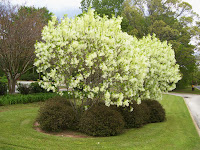
 Whether you know it as American Fringe Tree, Old Man's Beard, Grancy Gray Beard, or the common name given it by the British, Grandsir Graybeard (which is probably why some of us call it 'Grancy' Graybeard), Chionanthus Virginicus is one of the loveliest of all American native trees. Just looking at it takes my breath away. Easy to grow but difficult to find in local nurseries, Grancy Graybeard should be in every garden, native or not. This tree is drought tolerant and blooms in early spring. Blooms last up to a month, but the beauty lasts all season. Rich green elongated leaves stay beautiful all summer and are not bothered by pests. Even during winter when naked, the American Fringe is still very interesting. You can see for yourself the lovely 'puffy' white cloud-like blooms on the trees I saw as I passed through Shawmut, Alabama, in early April, 2008. As you can see, Chionanthus Virginicus grows well in full sun, but usually occurs naturally at the edge of woodlands. A very versatile plant, Grancy Graybeard is ideal for any garden. For more information on where to find this delightful tree, visit http://shadygardens.biz.
Whether you know it as American Fringe Tree, Old Man's Beard, Grancy Gray Beard, or the common name given it by the British, Grandsir Graybeard (which is probably why some of us call it 'Grancy' Graybeard), Chionanthus Virginicus is one of the loveliest of all American native trees. Just looking at it takes my breath away. Easy to grow but difficult to find in local nurseries, Grancy Graybeard should be in every garden, native or not. This tree is drought tolerant and blooms in early spring. Blooms last up to a month, but the beauty lasts all season. Rich green elongated leaves stay beautiful all summer and are not bothered by pests. Even during winter when naked, the American Fringe is still very interesting. You can see for yourself the lovely 'puffy' white cloud-like blooms on the trees I saw as I passed through Shawmut, Alabama, in early April, 2008. As you can see, Chionanthus Virginicus grows well in full sun, but usually occurs naturally at the edge of woodlands. A very versatile plant, Grancy Graybeard is ideal for any garden. For more information on where to find this delightful tree, visit http://shadygardens.biz.
Gardening for Wildlife is becoming more and more popular as gas prices keep many of us from traveling like we used to. We’re staying home more, building outdoor rooms, and planting beautiful gardens to enjoy with our family and friends. More and more money is spent on bird feeding each year, because it gives us so much joy. Attracting wildlife to the garden is really very simple. Our feathered friends need only a few things to make them happy: Food, water, and a safe place to nest and take shelter from predators. The best food for all wildlife is natural food sources—plants with berries and seeds are perfect. You can supplement that with feeders containing wild bird seed. Water is easy to provide—you don’t need a fancy pond or a babbling brook, although that would be nice. A simple birdbath or even just a saucer with fresh water will give the birds a place to drink and bathe. Remember to add fresh water daily. Nesting sights are equally easy to provide. You probably already have thick shrubs in your garden. Consider adding shrubs with spines or prickles and berries. The spines will help protect the birds from predators, and the berries will provide a convenient food source for them.Basically, all you have to do is plant a garden, and the birds will come!

 Whether you know it as American Fringe Tree, Old Man's Beard, Grancy Gray Beard, or the common name given it by the British, Grandsir Graybeard (which is probably why some of us call it 'Grancy' Graybeard), Chionanthus Virginicus is one of the loveliest of all American native trees. Just looking at it takes my breath away. Easy to grow but difficult to find in local nurseries, Grancy Graybeard should be in every garden, native or not. This tree is drought tolerant and blooms in early spring. Blooms last up to a month, but the beauty lasts all season. Rich green elongated leaves stay beautiful all summer and are not bothered by pests. Even during winter when naked, the American Fringe is still very interesting. You can see for yourself the lovely 'puffy' white cloud-like blooms on the trees I saw as I passed through Shawmut, Alabama, in early April, 2008. As you can see, Chionanthus Virginicus grows well in full sun, but usually occurs naturally at the edge of woodlands. A very versatile plant, Grancy Graybeard is ideal for any garden. For more information on where to find this delightful tree, visit http://shadygardens.biz.
Whether you know it as American Fringe Tree, Old Man's Beard, Grancy Gray Beard, or the common name given it by the British, Grandsir Graybeard (which is probably why some of us call it 'Grancy' Graybeard), Chionanthus Virginicus is one of the loveliest of all American native trees. Just looking at it takes my breath away. Easy to grow but difficult to find in local nurseries, Grancy Graybeard should be in every garden, native or not. This tree is drought tolerant and blooms in early spring. Blooms last up to a month, but the beauty lasts all season. Rich green elongated leaves stay beautiful all summer and are not bothered by pests. Even during winter when naked, the American Fringe is still very interesting. You can see for yourself the lovely 'puffy' white cloud-like blooms on the trees I saw as I passed through Shawmut, Alabama, in early April, 2008. As you can see, Chionanthus Virginicus grows well in full sun, but usually occurs naturally at the edge of woodlands. A very versatile plant, Grancy Graybeard is ideal for any garden. For more information on where to find this delightful tree, visit http://shadygardens.biz.